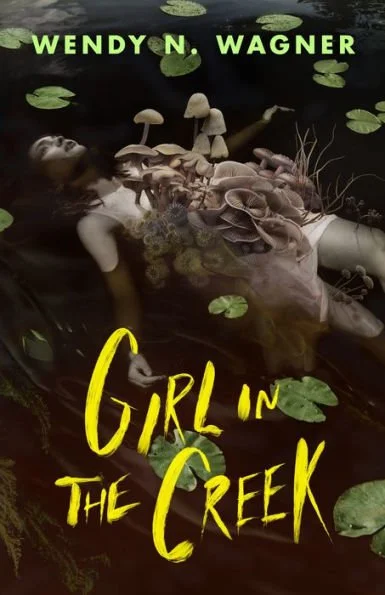TITLE: Girl in the Creek
AUTHOR: Wendy N. Wagner
262 pages, Tor Nightfire, ISBN 9781250908643 (hardcover, e-book, audiobook)
MY RATING: HIGHLY RECOMMENDED*
REVIEW: Girl in the Creek, Wendy N. Wagner’s new ecohorror novel from Tor Nightfire, manages to be claustrophobic and expansive at the same time, masterfully using beautiful descriptions of the Mount Hood region of the Pacific Northwest to make the reader feel trapped with the main character as things spiral out of control.
Travel reporter Erin comes to the small former mining town of Faraday with four friends (podcaster Hari, tech-savvy Matt, shelter for endangered women runner Kaylee, and Kaylee’s sister Madison) ostensibly to write an article about Faraday’s charm and eco-tourist-friendly attitude. She is really there to investigate a spate of missing persons cases, both for a possible book and episode of Hari’s podcast and to find emotional closure for the disappearance of her brother Bryan, which has been ruled by local police as a suicide with no body found. Erin and her gang immediately encounter locals both nice (hiking enthusiast Jared, river tour guide Dahlia), not nice (the Steadman brothers) and indeterminate (landlord Olivia Vanderpoel, deputy sheriff Duvall, local mushroom expert Ray). In the hands of some writers, juggling this many characters would be unwieldy at best, or they would mostly be played at stereotype level, filling their narrative roles without much depth. But Wagner has a wonderful knack for imbuing characters with depth in just a handful of sentences, forcing the reader to see beyond the “types” and come to care about them, which I happen to thin is a key component of effective horror fiction. I love slasher films as much as the next horror aficionado, but I never feel emotionally connected to most of the victims in such a film. Wagner made me care, so almost every death (and there are deaths, oh boy are there deaths) has emotional impact, even the ones that occur chronologically before the events of the book.
Wagner is also adept at establishing and maintaining mood. Despite being set largely outdoors, there is a pervading sense of claustrophobia that anyone who has ever been lost in the woods or crawling through a cave or stumbled through a dark house will recognize. Hours after finishing the book I still can’t quite shake the feeling. There is an undercurrent of looming danger that permeates every page and grows more distinct and precise as the threat becomes more apparent to the characters.
I have a love/hate relationship with mushrooms. Seen out in the wild, I find their variety of shapes and colors fascinating (sometimes morbidly so) and often can’t look away from them. But I also have a strict “no fungus” rule when it comes to what I eat (don’t bother trying to convince me otherwise. It’s been attempted. It won’t work). Wagner perfectly captured everything that fascinates me about wild fungi while also increasing my commitment to never eating any … thus perhaps proving why I would be one of the first victims if I existed in this book (or in any other fungi-based horror or SF story). I shall be looking even more askance at mushrooms, mycelium, mold, and mildew going forward.
I have not yet read any of the other recently released entries in what seems to be a trend of fungi-based horror, but I can highly recommend Girl in the Creek, Wendy N. Wagner’s entry into the genre.
I have previously reviewed some of Wendy N. Wagner’s short stories here and here, and plan to post reviews of her other novels soon.
*Starting now, I’ve decided to move away from a star-based rating system here on the blog (I can’t avoid using stars on Goodreads, NetGalley, and the various bookseller sites). Instead I am switching to ranking books as “highly recommended,” “recommended,” “satisfactory” and “not right for me.” I may add other levels as I refine this concept.
I received an electronic advance reading copy of this book for free from the publisher via NetGalley in exchange for an honest review. This does not affect my opinion of the book or the content of my review.


